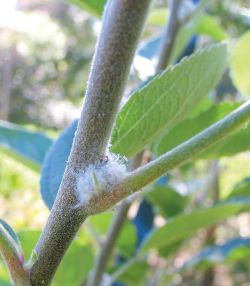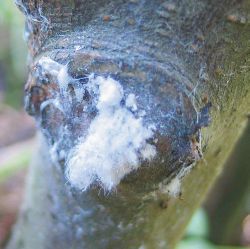Plant
Doctor Archive
Woolly
growth on fruit tree
  I
HAVE a dwarf apple tree that appears to have some sort of fungus
growing on it in patches. Should I spray it with a fungicide? I
HAVE a dwarf apple tree that appears to have some sort of fungus
growing on it in patches. Should I spray it with a fungicide?
 FROM
the photos you sent the problem looks more like woolly aphids than
a fungus disease. These aphids usually feed on the root system of
susceptible plants, particularly apples and relatives such as crabapples,
pyracanthas, cotoneasters and sometimes pears. But they also move
above ground and you can find them on new shoots, on the calyx end
of fruit or among cracks in the bark. FROM
the photos you sent the problem looks more like woolly aphids than
a fungus disease. These aphids usually feed on the root system of
susceptible plants, particularly apples and relatives such as crabapples,
pyracanthas, cotoneasters and sometimes pears. But they also move
above ground and you can find them on new shoots, on the calyx end
of fruit or among cracks in the bark.
 If
you pull the woolly threads apart you should find purplish-brown
aphids sheltering inside and you may also find them wandering around
outside their woolly haven, especially on new growth. They feed
by sucking sap, which damages buds, and badly affected trees can
end up looking quite twisted and deformed. They also secrete honeydew
which encourages the growth of sooty mould on leaves. If
you pull the woolly threads apart you should find purplish-brown
aphids sheltering inside and you may also find them wandering around
outside their woolly haven, especially on new growth. They feed
by sucking sap, which damages buds, and badly affected trees can
end up looking quite twisted and deformed. They also secrete honeydew
which encourages the growth of sooty mould on leaves.
Generally, woolly aphids
prefer moist conditions so tend to be more of a problem in cool,
shady gardens than in hot, sunny areas. In autumn they tend to move
down to the roots, especially in cold parts of the country.
There are a lot of contact
sprays you can use to control woolly aphids above ground, such as
pyrethrum, mineral oils (such as Eco Oil, Super Spraying Oil) and
Nature's Way Insect Spray, but you need to make sure to get thorough
coverage so the spray actually penetrates the woolly protective
coat and gets to the aphids. Alternatively, you could use a systemic
spray such as Rogor 100, Target or Confidor, or a combination product
like Fruit Tree Spray which controls a wide range of pests and diseases.
To control them on the
root system you could use Soil Insect Killer or Diazinon. Make sure
to follow all spray label recommendations carefully.
Weekend
Gardener, Issue 170, 2005, Page 28
Reproduced with permission from the former Weekend Gardener magazine. The views expressed here are not necessarily those of the RNZIH.
|
 |
 |
|